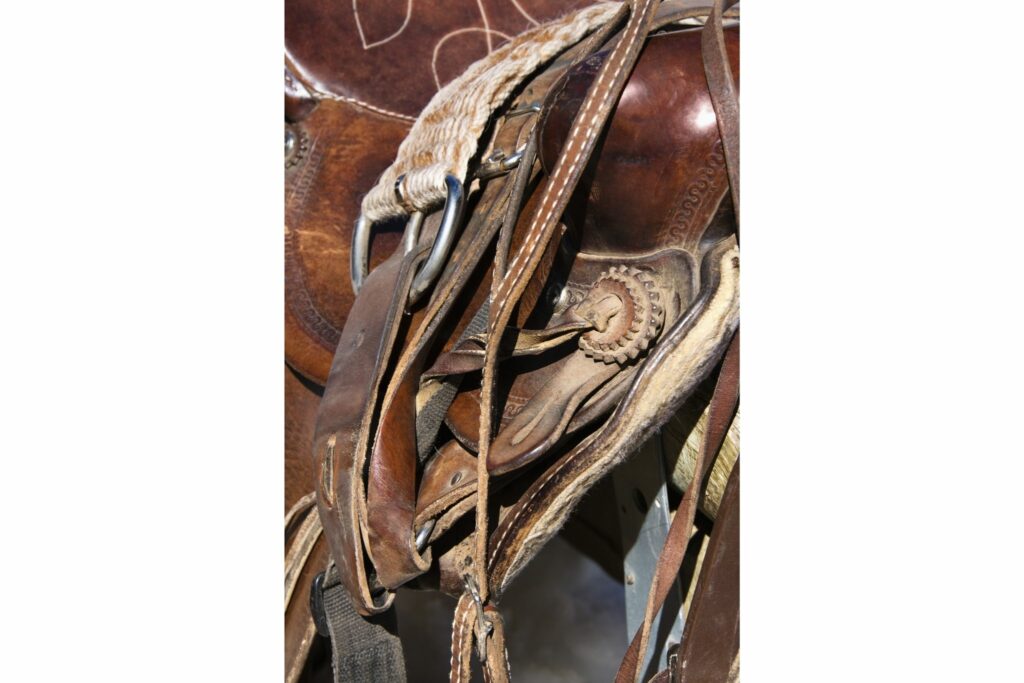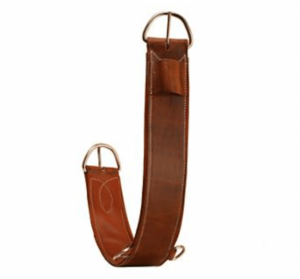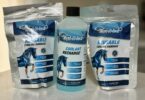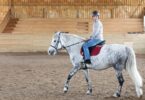Time to hit the trail!
Let’s face it, a cinch is one of the most important pieces of equipment to own—second only to your saddle. It helps keep your saddle and pad secure while riding and must be comfortable for your horse. Have you ever worn a belt or a pair of pants that were ill-fitting? Imagine wearing them for a long hike—you’d have rubs and sores in no time.
Trail riding can mean long hours in the saddle over uneven terrain. The best cinch for
Trail-tough cinches:
| Cinch | Key Features | Price Range |
| Total Saddle Fit – Shoulder Relief Cinch |
|
$$$ |
| Professionals Choice SMX Straight Cinch |
|
$ |
| Weaver 27-Strand Mohair Blend Straight Cinch
|
|
$ |
| Weaver AirFlex Roll Snug Roper Cinch |
|
$ |
| Tory Harness Leather Cinch |
|
$ |
| Professionals Choice Contoured Fleece Cinch |
|
$$ |
$ 50-100, $$ 100-150, $$$ 150+
Choose the Right Cinch Size
Ensuring your cinch fits correctly is critical for the comfort of your horse and stability of your saddle. The easiest way to choose the right size is to break out a measuring tape the next time you’re out at the ranch, or in the barn.
Total Saddle Fit recommends a “gap of about 8” from the top of the buckle on the cinch to the rigging on your saddle, on both sides.”
You want the end of the buckle to be above the elbow but below the curve of the ribs. This allows for the cinch to be free from the forelimb’s path of movement.
Most cinch sizes go up in increments of 2 inches. If you find yourself between sizes, it’s recommended to go for the larger size, since smaller cinches can lead to restriction and interference with your horse’s elbow.
It’s a good idea to reference the cinch’s manufacturer to follow any brand specific measuring techniques. This way you lessen the chance of bringing home a cinch that doesn’t fit.
Is there a best type of cinch for trail riding ?
Yes and no. Similar to saddles and other various equestrian tack, finding the best type of cinch for the trail depends on what you and your horse prefer.
For example, cinches made out of neoprene may be easy to clean, but are less breathable. Mohair string cinches are naturally moisture-wicking, but can sometimes pinch and are prone to stretching.
Fully understanding how your horse has reacted to past cinches is important information as you head out to purchase a new one.
Some questions to consider:
- Does my horse sweat easily?
- Does my horse have sensitive skin?
- Is easy maintenance important to me?
- Is my horse prone to girth sores?
- Do I want a cinch that will last a long time?
There are certainly “better” choices when it comes to

Photo Cred: Canva
Best Cinches for Trail Riding
Total Saddle Fit Shoulder Relief Cinch – Neoprene or Fleece
Total Saddle Fit created one of the first anatomically contoured cinches for western saddles. Its unique shape creates shoulder relief by redistributing the pressure caused by the cinch as well as providing space elbow clearance.
This cinch comes in options of either black or brown high quality leather and has a removable neoprene or fleece liner (depending on which option you choose).
PROS:
- Allows for full range of motion of the shoulder and shoulder blade
- Cut-out design creates a space for clearance of the elbow
- Removable liners make cleaning a breeze
CONS:
- The price tag is the highest on this list
- It can sometimes slide forward with horses that have a rounder shaped barrel
- It can be hard to center due to its shape
Professionals Choice SMX Straight Cinch
This straight cinch is a tried-and-true choice for
The neoprene backing also is removable which makes deep cleaning even easier.
PROS:
- Grippy material stays in place and doesn’t slip
- Easy to clean and wipe down
- Comes in various sizes to accommodate small and large breeds
CONS:
- Traps heat
- Can crack over time which can lead to skin irritation
Weaver 27-Strand Mohair Blend Straight Cinch
Made of Angora mohair blend, this straight cinch from Weaver Leather is a great option for horses that may sweat more easily and/or have sensitive skin.
Mohair naturally wicks away moisture and can be cleaned by brushing away any dirt or debris.
PROS:
- Extremely breathable
- Natural fiber material is a great horse that can’t handle neoprene
- Durable – will last a lifetime!
CONS:
- Has a tendency to stretch
- Risk of pinching between strands of mohair
- Harder to deep clean the fiber
Weaver AirFlex Roll Snug Roper Cinch
The Weaver AirfFlex Roll Snug cinch is great to utilize on horses that heat up quickly and benefit from a roper shape. Because of its wide design, pressure is more evenly distributed along the surface area of the cinch.
It has a unique roller buckle which makes tightening your cinch a breeze. Padded airflow channels give cushion and cool the sensitive belly area.
PROS:
- Grips without causing excessive sweating
- Made of white cool flex foam which doesn’t absorb heat.
- Made of materials that can be wiped or rinsed off
CONS:
- Due to the size of the buckles, it can be harder to measure for
- Can be harder to fit on larger horses
Tory Harness Leather Cinch
This long-lasting leather cinch will withstand even the toughest of rides. Made of harness leather with rolled edges, this cinch will prevent chafing and slippage while remaining tight.
It has reinforced ends with a leather billet keeper and can be wiped down with a damp cloth after rides.
PROS:
- Will not stretch or slip
- Extremely durable and long lasting
- Will hold up to sweat and dirt
CONS:
- The buckles can sometimes pinch when tightening the cinch
- Requires leather oil and conditioning to keep leather supple
Professionals Choice Contoured Fleece Cinch
The Professionals Choice Contoured Fleece Cinch is the perfect option for horses that are thin-skinned and prone to irritation.
The fleece backing adds an extra layer of padding as well as wicking away moisture from this high-heat area.
PROS:
- Contoured design for greater shoulder mobility
- Fleece material is great for horses with sensitive skin
- More affordable than other anatomical western cinches
CONS:
- The fleece is not removable which makes cleaning more difficult
Frequently Asked Questions
Q: Do mohair cinches slip?
Mohair cinches are more likely to stretch than slip. This being said, proper tightness needs to be achieved with ALL cinches to ensure that they do not slip.
Q: What is the difference between a roper cinch and a regular cinch?
The main difference between a roper cinch and a regular cinch is their shape. A roper cinch will have a wider portion through the middle which allows for a larger surface area for pressure distribution along your horse’s breast bone and ribs. A regular cinch is straight in shape.
Q: How do you cinch a trail saddle?
There are two schools of thought when it comes to fastening your cinch on a trail saddle. Riders either choose to tie a knot, like the “Texas T,” or utilize the buckle on the cinch.
Whichever you choose is personal preference. For example, I grew up tying the “Texas T” but now strictly use the buckle as it frees up space and bulk in front of my leg. Try out both options and see which you prefer!
Q: What’s the best western cinch for a sensitive horse?
If your horse has sensitive skin, pay most attention to the material the cinch is made out of. Materials such as fleece or wool will wick away sweat and moisture which is usually the culprit of skin irritation.
Q: What’s the best girth for horse comfort?
With comfort in mind, contoured and anatomically correct girths/cinches will be your best option. This type of cinch has been scientifically proven to reduce the amount of pressure placed behind your horse’s elbows.
Q: What’s the average cinch size for a quarter horse?
The average cinch size for a quarter horse will be anywhere from 24-30 inches, depending on how deep bodied and muscled they are.
Q: What’s the best girth for girth sores?
If your horse has girth sores it’s important to first stop riding until they are fully healed. Once healed, choose a girth that is fleece lined in order to give your horse an extra layer between the leather and the horse’s skin.
It’s also very important that your girth is clean and free of build-up as this can create friction and more sores down the road, or trail.
Parting Thoughts
When it comes to choosing a cinch for
By learning about the various cinch options such as shape, style, and material, you can pick the best choice for your horse and feel confident while doing so. Happy trails to you!
P.S. If you enjoyed this article, trot on over to:
- Happy Trail Gear Guide: What to Wear Horseback
Trail Riding - Gaited Horses for Beginners: What You Need to Know!
- Horse
Trail Riding on Steroids: Extreme Mountain Trail 101 - 5 Best Hobbles for Helping Horses & Mules Stay Put
- Appendix Quarter Horses: A Winning Combination
- 7 Best Stirrups for
Trail Riding in All-Day Comfort - 7 Best Boots for Horse
Trail Riding in Harmony - Ultimate Beginner’s Guide to Horseback
Trail Riding at Night - 5 Best Horse Bits for
Trail Riding Success - 7 Best Satellite Phones for Horse Riders Who Need Help NOW
- 6 Best Saddle Pads for
Trail Riding and Happy Horses
Source
https://www.totalsaddlefit.com/collections/shop













